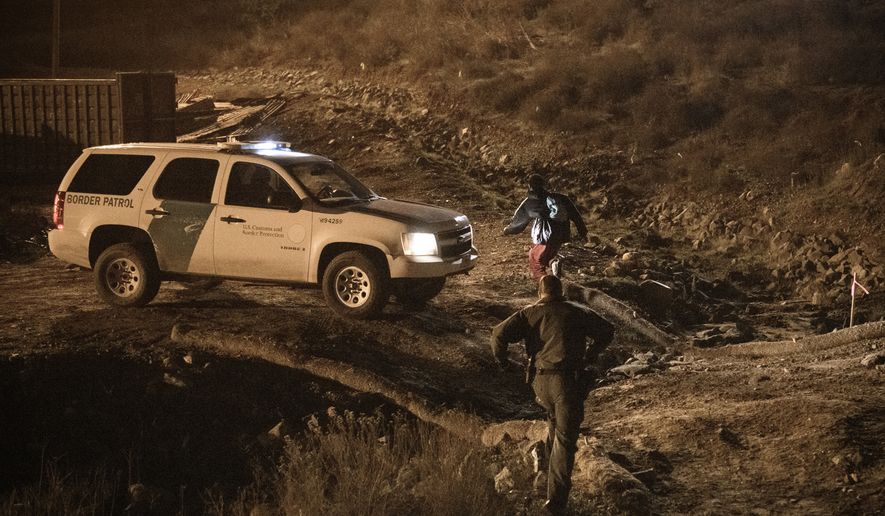Illegal immigration across the southwestern border is down so much that the Department of Homeland Security is deporting more people each month than it captures coming across, officials announced Thursday, meaning they are now able to eat into the backlog of cases that built up during last year’s surge.
Over the past five months, 14,000 more people were removed or returned across the Mexican border than arrived, including 1,170 in February.
Acting Customs and Border Protection Commissioner Mark A. Morgan said the number of illegal crossings ticked up slightly in February but was still far below the heights of last year’s wave.
He said the nature of the flow looks dramatically different now. Last year, smugglers were recruiting Central American families. Now they are looking at single adult Mexicans, Ecuadorians and Brazilian families.
But he said CBP is in better shape to deal with the situation, thanks to policies put into place and deals struck with Mexico and Central American countries over the past year, which give the government the chance to do something beyond releasing illegal immigrants into U.S. communities.
“We’ve got the tools in place now where we have the capacity to remove more people than we’re actually apprehending,” Mr. Morgan told reporters before announcing the February numbers.
After eight months of declines, the number of people apprehended by Border Patrol agents or encountered by officers at ports of entry ticked up from about 36,650 in January to about 37,100 in February.
Mr. Morgan said an increase from January to February is typical, though this year’s is the second smallest in the past decade. February’s total was just half of what it was in February 2019, when about 76,550 unauthorized migrants were caught trying to enter.
The worst month was May, when more than 144,000 migrants were nabbed. Of those, more than 80,000 were immediately released into communities because there was no way to hold and quickly deport them under a patchwork of laws and court rulings.
Most are still in the U.S., authorities believe.
But the lower numbers at the border mean Homeland Security may finally cut into the backlog.
“For the last five months, the number of those we removed have outpaced the number we have encountered at the southwest border,” Mr. Morgan said.
In January, Homeland Security ousted nearly 42,000 illegal immigrants, about 5,200 more than were nabbed at the border.
In February, at least 38,300 people were removed or returned across the border — about 1,200 more than arrived.
Mr. Morgan said President Trump deserves credit for pushing the changes that allowed the U.S. government to get a handle on the situation. The administration suspended aid payments to key Central American countries until they agreed to do more to keep their people at home and to try to stop migrants from other nations from using their territory as a crossing point.
Mr. Trump personally threatened to slap tariffs on Mexico, which brought Mexican officials running to Washington to cut a deal. They agreed to expand their own immigration enforcement efforts and to accommodate people from Central America who crossed Mexican territory en route to the U.S., whom the U.S. then pushed back across the border to wait for their immigration court dates.
That U.S. policy, officially known as the Migrant Protection Protocols but more commonly called “Remain in Mexico,” has been a critical part of cutting the flow of Central Americans.
Immigrant rights activists call the Migrant Protection Protocols an abuse of human rights. They say the policy forces asylum-seekers to suffer dangerous conditions in Mexico and point to reports that have documented kidnappings and other violence perpetrated on migrants.
Homeland Security says those are generally cases in which the migrants, after being returned to Mexico, deal with smuggling cartels again for another attempt to jump the border.
Mr. Morgan said cartels have lost hundreds of millions of dollars of profit in recent months thanks to the massive drop in human smuggling across the border. Cartels charge $3,000 to more than $15,000 to smuggle a Central American into the U.S.
Sapped of those customers, the cartels are targeting others. In Ecuador, people are paying up to $17,000 per person to be smuggled into the U.S.
Brazil was a major source late last year, but the U.S. government expanded its Migrant Protection Protocols deal with Mexico to allow Brazilians to be pushed back across the border. The numbers plunged immediately, from more than 1,600 in November to 682 in February, according to Homeland Security data.
What most concerned Mr. Morgan in the February numbers was a spike in drug seizures.
He said fentanyl seizures were up 75% from January to February, cocaine was up 41%, heroin was up 11% and methamphetamine was up 30%.
Like migration, where a rise in the level of arrests is believed to mean a rise in the number of people sneaking in successfully, a rise in seizures is believed to signal a rise in the amount of drugs getting through.
Although the largest amount flows through ports of entry in vehicles or strapped to travelers’ bodies, he said, Border Patrol agents have reported increasing seizures between ports.
Mr. Morgan said that is another argument for finishing the border wall. He said that can funnel activity to the ports, where each vehicle can be screened, or it can force them to try to bypass the wall with drug tunnels.
“We want to drive them to take extreme measures to force them to spend a lot of time, effort and money to come up with new ways,” he said. “We want to make it hard for them.”
He pointed to the discovery of a second drug tunnel along the border this year as evidence that the plan is working.
“The smugglers are getting desperate,” he said.
• Stephen Dinan can be reached at sdinan@washingtontimes.com.




Please read our comment policy before commenting.